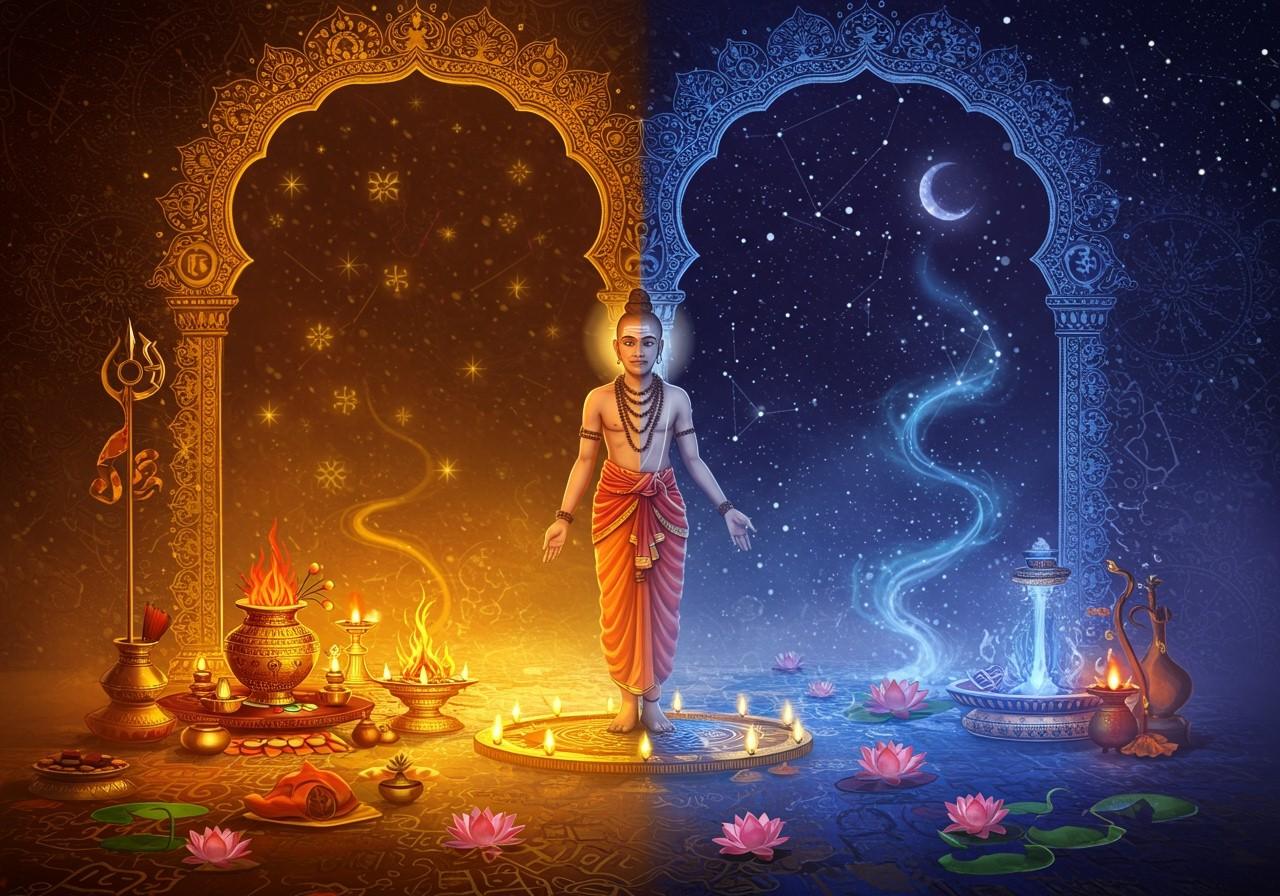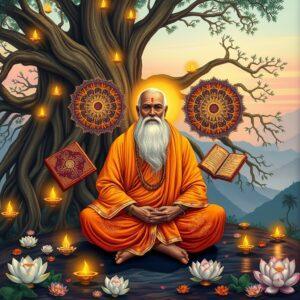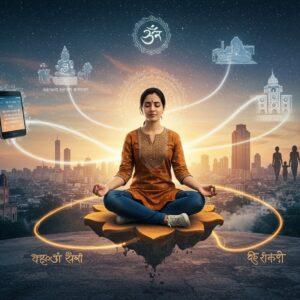
Mimamsa, derived from the Sanskrit word meaning “reflection” or “examination,” stands as a cornerstone among the six classical schools of Indian philosophy. It branches into two distinct streams: Purva Mimamsa (Karma-Mimamsa) and Uttara Mimamsa (Vedanta). Each offers a unique lens through which to interpret Vedic texts and rituals, addressing profound questions concerning dharma (duty) and moksha (liberation). For those deeply rooted in their cultural heritage, understanding these branches provides invaluable insights into tradition and authentic ritual practices.
What is Purva Mimamsa Philosophy?
Purva Mimamsa, often referred to as Karma Mimamsa, delves into the ritualistic core of the Vedas. It underscores the significance of performing Vedic rituals (karma) as a means of upholding dharma and generating positive consequences. This school meticulously examines the intricacies of ritual performance, emphasizing the precise execution of prescribed actions.
Key Aspects of Purva Mimamsa:
- Significance of Ritual Actions: Purva Mimamsa posits that ritual actions generate unseen results known as apūrva, which contribute to both individual and cosmic well-being. These actions are not merely symbolic but possess an inherent power to effect change.
- Role of Yajnas: Sacrificial rites, known as yajnas, hold a central place in Purva Mimamsa. These rituals are believed to maintain cosmic order, appease deities, and secure blessings for both the individual and the community. They are seen as a vital link between the human and divine realms.
- Concept of Dharma: Dharma, according to Purva Mimamsa, represents a set of prescribed duties and obligations derived from the Vedas. Adherence to dharma is essential for maintaining social harmony and individual spiritual growth. It provides a framework for ethical conduct and righteous living.
- Authority of Vedas: Purva Mimamsa upholds the absolute authority of the Vedas as a source of eternal knowledge. The Vedas are considered apauruṣeya, meaning “not of human origin,” and thus possess divine legitimacy. They are the ultimate guide for understanding ritual and dharma.
- Interpretation of Mantras and Brahmanas: Mantras and Brahmanas, specific sections of the Vedas, provide detailed instructions for the proper execution of rituals. Purva Mimamsa scholars dedicate themselves to the meticulous interpretation of these texts, ensuring the preservation of authentic ritual practices.
- Founder Jaimini: Jaimini, the author of the Purva Mimamsa Sutras, is considered the founder of this school of thought. His sutras provide a systematic framework for understanding the principles of Mimamsa and interpreting Vedic injunctions.
- Eternality of Sounds and Mantras: A core tenet of Purva Mimamsa is the belief in the eternality of sounds and mantras. They are not merely human constructs but intrinsic elements of the cosmos, possessing inherent power and significance.
What is Uttara Mimamsa?
Uttara Mimamsa, widely known as Vedanta, shifts its focus from the practical aspects of ritual to a deeper philosophical inquiry into the nature of reality and the pursuit of liberation (moksha). It delves into the metaphysical underpinnings of existence, exploring the relationship between the individual self (Atman) and the ultimate reality (Brahman).
Key Aspects of Uttara Mimamsa:
- Primary Texts: Uttara Mimamsa draws its wisdom from the Upanishads, Brahma Sutras, and Bhagavad Gita. These texts offer profound insights into the nature of reality, consciousness, and the path to liberation.
- Concepts of Brahman and Atman: Brahman is the ultimate reality, the ground of all being, while Atman represents the individual self or soul. Uttara Mimamsa explores the relationship between these two fundamental concepts, leading to various interpretations and schools of thought.
- Pursuit of Moksha: The ultimate goal of Uttara Mimamsa is moksha, liberation from the cycle of birth and death. This is achieved through knowledge (jnana) and self-realization, recognizing the true nature of Atman and its identity with Brahman.
- Key Philosophers: Uttara Mimamsa has been enriched by the contributions of renowned philosophers like Adi Shankaracharya, Ramanuja, and Madhva. Each of these figures offered unique interpretations of Vedanta, leading to the development of distinct schools of thought.
- Sub-Schools within Vedanta: Vedanta encompasses various sub-schools, including Advaita (non-dualism), Vishishtadvaita (qualified non-dualism), and Dvaita (dualism). These schools offer different perspectives on the relationship between Brahman and Atman.
- Nature of Maya: Maya, the concept of illusion, plays a crucial role in Uttara Mimamsa. It is seen as the veil that obscures the true nature of reality, perpetuating the cycle of birth and death.
- Individual Soul (Jiva) and Brahman: Uttara Mimamsa delves into the complex relationship between the individual soul (jiva) and Brahman, exploring the nature of their connection and the path to ultimate union.
Comparative Analysis of Purva and Uttara Mimamsa
Although both branches originate from the Vedas, their focus and philosophical approaches differ significantly. Purva Mimamsa emphasizes ritual action as the primary means of upholding dharma, while Uttara Mimamsa prioritizes philosophical inquiry and self-knowledge as the path to liberation.
Key Differences:
| Feature | Purva Mimamsa | Uttara Mimamsa |
|---|---|---|
| Primary Texts | Samhitas, Brahmanas | Upanishads, Brahma Sutras, Bhagavad Gita |
| Focus | Ritual actions, Dharma | Philosophical inquiry, Moksha |
| Goal | Maintaining cosmic order through Karma | Liberation through self-realization |
| Methodology | Hermeneutics (interpretation of rituals) | Metaphysical analysis |
Relevance and Application in Modern Times
Despite their ancient origins, both Purva and Uttara Mimamsa continue to influence contemporary Hindu thought and practice. Vedic rituals remain integral to many ceremonies and daily observances, while Vedantic principles guide spiritual seekers on their path to self-discovery.
How Poojn.in Supports Your Vedic Studies and Rituals
Poojn.in, India’s leading online store for cultural goods and services, provides a wide range of products to support both Purva and Uttara Mimamsa practices. Whether you are a scholar seeking authentic Vedic texts or a practitioner in need of ritual items, Poojn.in offers a comprehensive selection to meet your needs.
For Purva Mimamsa practitioners, we offer:
Mangalam Camphor
Kushal Mangal Sandalwood Agarbatti
A range of copper and brass ritual items.
For those following the path of Uttara Mimamsa, we provide:
Spiritual texts and commentaries
Meditation accessories.
Visit Poojn.in today to explore our complete collection and enhance your Mimamsa practices.
Conclusion
Understanding both Purva and Uttara Mimamsa provides a comprehensive appreciation of Indian philosophical thought. These branches, though distinct, offer invaluable insights into the nature of rituals, dharma, and the pursuit of moksha. By studying and applying these teachings, we can enrich our spiritual lives and uphold the timeless values at the heart of Hindu philosophy.


